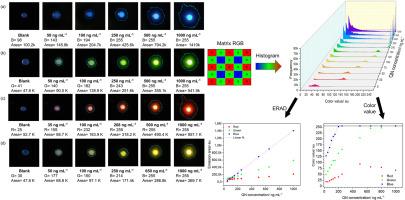基于荧光数字图像利用感兴趣区域检测:一种新的方法,化学数据解释在数字成像
IF 6
2区 化学
Q1 CHEMISTRY, ANALYTICAL
引用次数: 0
摘要
基于数码相机的分析已成为科学领域的重要工具,其中色彩模型值被用作定量信息以进行校准。然而,色彩模型表现出动态范围的局限性,这限制了基于数字图像的方法的线性范围。为了解决这一问题,提出了一种基于数字图像发射区域的信号分析方法。本文首次报道了基于荧光数字图像的感兴趣区检测(FDIB-ROID)分析方法。结果FDIB-ROID方法采用奎宁(QN)、罗丹明6G (RDA-6G)、罗丹明B (RDA-B)和4-二氰亚甲基-2-甲基-6-(对二甲氨基苯基)- 4h吡喃(DCM)等全可见光谱发射分析物,实现了信号与浓度之间的线性关系。这种方法是使用3D打印制造的新型便携式设备发现的,该设备在紫外线到可见光区域(从300到800纳米)激发,可探测性与商用荧光光谱仪相似。QN的浓度范围为50 ~ 1000 ng mL-1,检出限为10 ng mL-1,线性回归R2为0.998。因此,该方法的准确性、精密度、重现性和灵敏度通过测量商业样品的QN得到验证。FDIB-ROID方法在其他研究结果中得到了有效的应用,克服了经典方法的局限性。这一新方法为基于数字图像的方法提供了更广泛的分析信号范围。它克服了仅仅依靠颜色模型值作为分析信号的固有局限性。对ROID的深入了解有助于设计和开发具有更高灵敏度和更大动态工作范围的新型工具。本文章由计算机程序翻译,如有差异,请以英文原文为准。

Fluorescence digital image-based utilizing region of interest detection: a novel approach for chemical data interpretation in digital imaging
Background
Digital camera-based analysis has become an important tool in the scientific field, where colour model values are employed as quantitative information for calibration purposes. However, colour models exhibit limitations in dynamic range, which restricts the linear range of digital image-based methods. To address this issue, a novel analytical signal approach based on emission areas in digital images has been developed. This new method, termed fluorescence digital image-based analysis with region of interest detection (FDIB-ROID), is reported here for the first time for analyte determination.Results
The FDIB-ROID method achieved a linear relationship between the signal and concentration by employing emission analytes across the entire visible spectrum using quinine (QN), rhodamine 6G (RDA-6G), rhodamine B (RDA-B), and 4-Dicyanomethylene-2-methyl-6-(p-dimethylaminostyryl)-4H-pyran (DCM). This approach was discovered using new portable equipment built by 3D printing, with excitation in the ultraviolet to visible region (from 300 to 800 nm) and detectability similar to that of a commercial spectrofluorometer. The concentration range obtained for QN was from 50 ng mL-1 to 1000 ng mL-1, with a detection limit of 10 ng mL-1 and a linear regression with an R2 of 0.998. Thus, the accuracy, precision, reproducibility, and sensitivity of the method were validated by measuring QN in commercial samples. The FDIB-ROID approach has been efficiently employed in results of other studies, and the limitations of the classical approach have been overcome.Significance
This new approach provides a broader analytical signal range for digital image-based methods. It overcomes the inherent limitations of relying solely on colour model values as analytical signals. A deeper understanding of ROID enables the design and development of novel tools that offer enhanced sensitivity and an extended dynamic working range.求助全文
通过发布文献求助,成功后即可免费获取论文全文。
去求助
来源期刊

Analytica Chimica Acta
化学-分析化学
CiteScore
10.40
自引率
6.50%
发文量
1081
审稿时长
38 days
期刊介绍:
Analytica Chimica Acta has an open access mirror journal Analytica Chimica Acta: X, sharing the same aims and scope, editorial team, submission system and rigorous peer review.
Analytica Chimica Acta provides a forum for the rapid publication of original research, and critical, comprehensive reviews dealing with all aspects of fundamental and applied modern analytical chemistry. The journal welcomes the submission of research papers which report studies concerning the development of new and significant analytical methodologies. In determining the suitability of submitted articles for publication, particular scrutiny will be placed on the degree of novelty and impact of the research and the extent to which it adds to the existing body of knowledge in analytical chemistry.
 求助内容:
求助内容: 应助结果提醒方式:
应助结果提醒方式:


